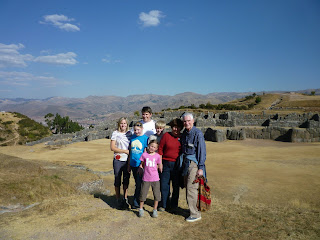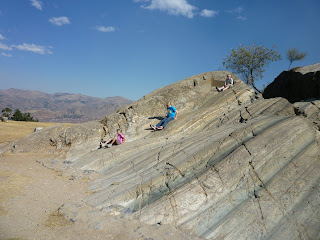 We entered Sacsayhuman from high above the stone walls. Actually, we entered through a stone cave, at one point quite dark and disarming. We exited onto what seemed like a broad playing field. The view down to Cusco was really beautiful.
We entered Sacsayhuman from high above the stone walls. Actually, we entered through a stone cave, at one point quite dark and disarming. We exited onto what seemed like a broad playing field. The view down to Cusco was really beautiful. This is just one small section of the massive wall of stones. There is evidence the wall was much higher and, like other Inca structures, this wall has no mortar. The stones are fitted perfectly together. The stones incline or lean into the center. The inclination of the stones strengthens the wall. Ofelia had pointed the inclination out to us at the sites in Cusco.
This is just one small section of the massive wall of stones. There is evidence the wall was much higher and, like other Inca structures, this wall has no mortar. The stones are fitted perfectly together. The stones incline or lean into the center. The inclination of the stones strengthens the wall. Ofelia had pointed the inclination out to us at the sites in Cusco. From this side of the great stone which weighs about 20 ton, the upper walls are visible. It is one of the upper walls that was washed out in the heavy February and March rain storms.
From this side of the great stone which weighs about 20 ton, the upper walls are visible. It is one of the upper walls that was washed out in the heavy February and March rain storms.One wonders how they moved such a stone into place or for that matter hoisted the other stones to fit so snugly. Ofelia said there is evidence they used logs to roll the stones from the quarry which was up on the upper ledge. But how they lifted them in place is somewhat of a mystery. There was some kind a pulley system, one guide told us.
 Ofelia pointed out the angles of the stones, somel 12 sided. Notice the varied shapes.
Ofelia pointed out the angles of the stones, somel 12 sided. Notice the varied shapes.
 Emma saw the Utah stone first. Of course, we had to have our pictures taken in front of it. A few minutes later we found another even more pronounced Utah shaped stone.
Emma saw the Utah stone first. Of course, we had to have our pictures taken in front of it. A few minutes later we found another even more pronounced Utah shaped stone.
 This picture is deceiving. The walls look short and close together. The truth is we are on the high bluff overlooking the walls. Where we are standing has been recently excavated and developed. We walked down a mountain-side of stone steps to reach the field and the great stones. When we were there in 2006, this area was under excavation.
This picture is deceiving. The walls look short and close together. The truth is we are on the high bluff overlooking the walls. Where we are standing has been recently excavated and developed. We walked down a mountain-side of stone steps to reach the field and the great stones. When we were there in 2006, this area was under excavation.
 We were on our way out of the site when Ofelia offered to take this picture. You can see the city below and the end stones to the great wall.
We were on our way out of the site when Ofelia offered to take this picture. You can see the city below and the end stones to the great wall.
 While we were standing on the upper plateau, this man, who looked very much like a North American Indian, walked past us, settled himself against one of the terraces, and began to play music which sounded very much like North American Indian music. The sound of his recorder echoed off the stones. It was hauntingly beautiful and a little distracting because it was hard to follow Ofelia's history lesson.
While we were standing on the upper plateau, this man, who looked very much like a North American Indian, walked past us, settled himself against one of the terraces, and began to play music which sounded very much like North American Indian music. The sound of his recorder echoed off the stones. It was hauntingly beautiful and a little distracting because it was hard to follow Ofelia's history lesson.
 We appreciated Ofelia so much. She led us to this rock slide so the kids could have some play time. Throughout the 10 days, we recognized the value of having private guides and vans because we could do some fun or side things we couldn't have done if we had been with a busload of people.
We appreciated Ofelia so much. She led us to this rock slide so the kids could have some play time. Throughout the 10 days, we recognized the value of having private guides and vans because we could do some fun or side things we couldn't have done if we had been with a busload of people.
 Ofelia pointed out the angles of the stones, somel 12 sided. Notice the varied shapes.
Ofelia pointed out the angles of the stones, somel 12 sided. Notice the varied shapes.  Emma saw the Utah stone first. Of course, we had to have our pictures taken in front of it. A few minutes later we found another even more pronounced Utah shaped stone.
Emma saw the Utah stone first. Of course, we had to have our pictures taken in front of it. A few minutes later we found another even more pronounced Utah shaped stone.  This picture is deceiving. The walls look short and close together. The truth is we are on the high bluff overlooking the walls. Where we are standing has been recently excavated and developed. We walked down a mountain-side of stone steps to reach the field and the great stones. When we were there in 2006, this area was under excavation.
This picture is deceiving. The walls look short and close together. The truth is we are on the high bluff overlooking the walls. Where we are standing has been recently excavated and developed. We walked down a mountain-side of stone steps to reach the field and the great stones. When we were there in 2006, this area was under excavation.  We were on our way out of the site when Ofelia offered to take this picture. You can see the city below and the end stones to the great wall.
We were on our way out of the site when Ofelia offered to take this picture. You can see the city below and the end stones to the great wall. While we were standing on the upper plateau, this man, who looked very much like a North American Indian, walked past us, settled himself against one of the terraces, and began to play music which sounded very much like North American Indian music. The sound of his recorder echoed off the stones. It was hauntingly beautiful and a little distracting because it was hard to follow Ofelia's history lesson.
While we were standing on the upper plateau, this man, who looked very much like a North American Indian, walked past us, settled himself against one of the terraces, and began to play music which sounded very much like North American Indian music. The sound of his recorder echoed off the stones. It was hauntingly beautiful and a little distracting because it was hard to follow Ofelia's history lesson. We appreciated Ofelia so much. She led us to this rock slide so the kids could have some play time. Throughout the 10 days, we recognized the value of having private guides and vans because we could do some fun or side things we couldn't have done if we had been with a busload of people.
We appreciated Ofelia so much. She led us to this rock slide so the kids could have some play time. Throughout the 10 days, we recognized the value of having private guides and vans because we could do some fun or side things we couldn't have done if we had been with a busload of people.


No comments:
Post a Comment